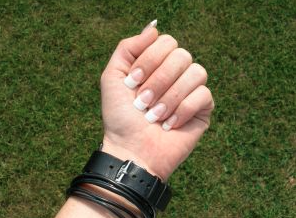 Even though acrylic nails look good on a woman’s hands, they may be a hidden source of nail fungus. Here are some examples of nail fungus caused by artificial nails, and six ways to cure the problem.
Even though acrylic nails look good on a woman’s hands, they may be a hidden source of nail fungus. Here are some examples of nail fungus caused by artificial nails, and six ways to cure the problem.
To avoid this problem, it is important to understand what causes the fungus and various treatment options.
Six Ways to Treat Nail Fungus Caused by Artificial Nails
1. Remove Fake Nails and Trim Natural Nails. The best way to kill fungus is to remove artificial nails. Keeping a fungal infection covered will only make the problem worse. Also, natural nails should be short and straight. Stop the use of any nail products until the infection clears.
2. Antifungal Nail Lacquer. Penlac nail polish treats fungus on the nails. It is made for application on infected nails and the skin around them.
3. Prescription Antifungal Medication. When a person detects a fungal infection, it is best to consult with a doctor. A physician will prescribe an oral medicine that can lessen the healing time and prevent the fungus from spreading. A popular antifungal is Diflucan. But, this drug may need to be taken for up to six weeks.
4. Vinegar. Both white and apple cider vinegar are effective remedies for fingernail fungus. A person can soak the hands in vinegar for 30 minutes each day until the problem is healed. It is also possible to take an oral vinegar supplement that will fight the fungus from the inside of the body.
5. Hydrogen Peroxide and Water. Mixing a solution of equal parts hydrogen peroxide and water will create a good treatment for fungus on the nails. Soaking in this liquid for 30 minutes each day should help fix the problem.
6. Tea Tree Oil. Many essential oils contain antifungal properties. One of the most effective oils to get rid of fungus and heal is tea tree oil. Massaging a few drops of this oil onto the effected nail should stop the fungus.
What Causes Nail Fungus When Using Artificial Nails?
When a person has acrylic nails applied to the hands, the nails must be filed, thickened, and completely altered. This is why fungus tends to develop between the nails’ layers. As nail polish adds to the problem by supplying a moist environment that fungus loves.
Another way that acrylic nails may cause fungus is by the use of unclean tools. Many nail salons do not properly clean tools between customers. This means that fungus can spread from one person to the next.
Fungus is most common when artificial nails don’t fit properly. When the nails are lifted and do not totally cover natural nails, the space allows water to penetrate. This is a breeding ground for fungus and other infections.
When applying nails at home, it is vital to make sure the fake nails are flush with the nail beds and don’t lift around the edges.
Preventing Fingernail Fungus from Acrylic Nails
To keep nail fungus away, there are a few things to watch. To begin, it is important to find a clean salon that washes and sterilizes equipment after each client. The nail technician should wash their hands after each client as well.
If a person notices that a nail is lifting or does not fit properly, it must be removed or glued back into position. This keeps moisture from forming. Any person who works around water should not use acrylic nails. Water will weaken the glue and can cause nails to lift.


